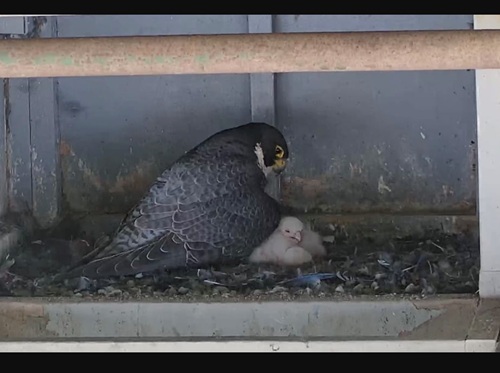A pair of peregrine falcons have successfully nested on the U.S. side of the Sault Ste. Marie International Bridge that connects Michigan and Canada – continuing a nesting tradition established in 2010, when nesting boxes were first installed on the structure.
[Above image via the Michigan DOT]
One of the duties of the Michigan Department of Transportation, via its Bureau of Bridges and Structures, is to ensure all bridges and structures are designed, constructed, maintained, and operated to ensure safety of the traveling public.
The agency helped install the first nesting boxes 15 years ago on the International Bridge and, over that time, falcons have hatched over 45 chicks in those nesting locations.
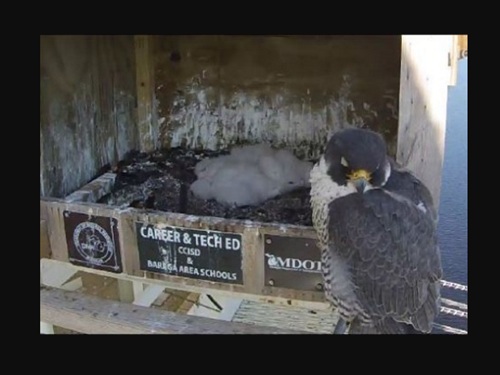
While the falcons are just now beginning the process of nesting this year, a pair of peregrines hatched four chicks in the same location – though, according a Michigan DOT statement, it is not currently known if it is the same pair that has nested on the bridge between the U.S. and Canada for years.
The agency said that while the peregrine falcon has been removed from the federal endangered species list, it is still listed as a threatened species in Michigan – protected by state and federal law. While they historically nested on cliff faces in Michigan, peregrine falcons have adapted well to city habitats, nesting on tall buildings, smokestacks, bridges and other man-made structures around the world.
Meanwhile, in Canada, peregrine populations – designated “not at risk” in Canada, except for one subspecies listed as of “special concern” on the Federal Species at Risk Act – have also increased in recent years.
Several years ago, Michigan DOT helped install a video camera on the nest box. Dubbed the “FalCam,” this live video stream — available at www.saultbridge.com/falcam — offers bird watchers a front row seat for the seasonal activities of the airborne hunters, with spring the best time to view the birds.
Across the country, state departments of transportation are involved in a wide range of efforts to both create and protect wildlife habitats.
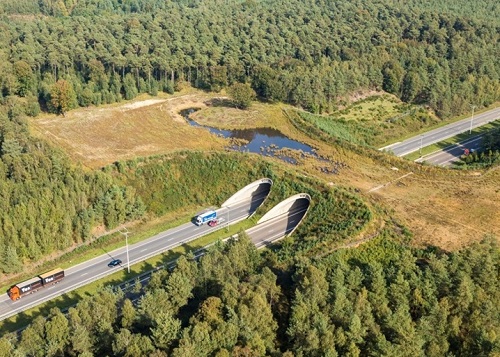
For example, in October 2024, the California Department of Transportation – known as Caltrans – issued a Wildlife Connectivity Report that identified more than 140 locations where roadways can be better integrated with the migration needs of animals statewide.
Caltrans is also working with the California Department of Fish and Wildlife or CDFW to implement a strategy to address wildlife connectivity barriers across the state’s vast transportation network while better protecting and restoring biodiversity.
To that end, Caltrans said its new report proposes numerous projects designed to remediate fish and wildlife barriers – as well as construct dozens of migration corridors adjacent to state highways and interstates – helping approximately 180 native, endangered, or threatened animal species to move more freely and have better access to their natural habitats.
Meanwhile, in August 2024, the Alabama Department of Transportation detailed the critical roadside vegetation management work conducted by its “agronomists,” who are scientists specializing in the study and care of crops and plants, conducting research to improve growth, production quality, and to combat diseases. In the agricultural sector, they often act as liaisons between farmers and researchers.
Alabama DOT’s agronomists develop guidelines for mowing operations and the use of herbicides as well as broader policies to support pollinators and wildlife in and around the state’s road network; experimenting with different management practices to create habitats beneficial to all wildlife.
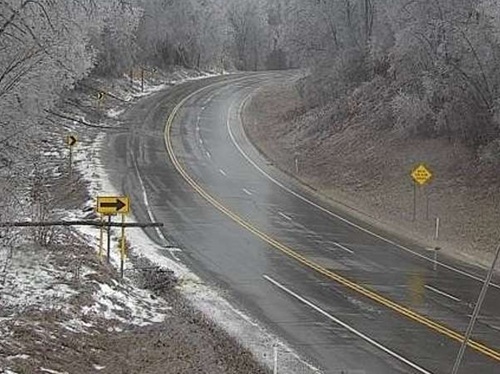 States
States
Podcast: Flashing LED Lights Can Boost Roadway Safety
December 5, 2025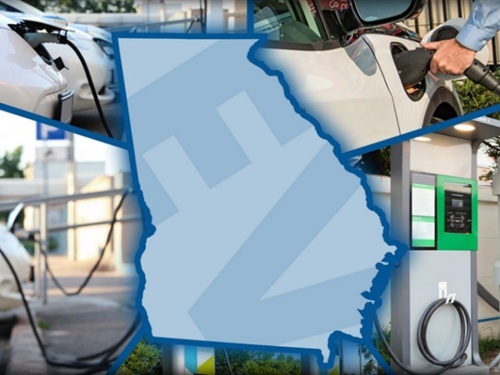 States
States
